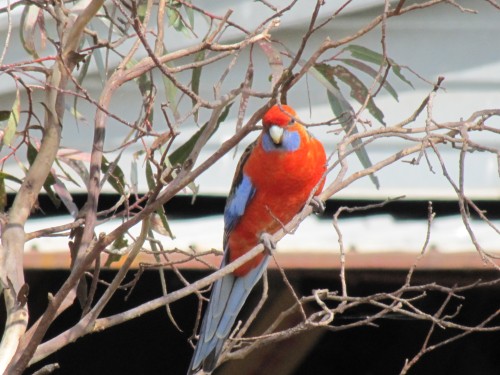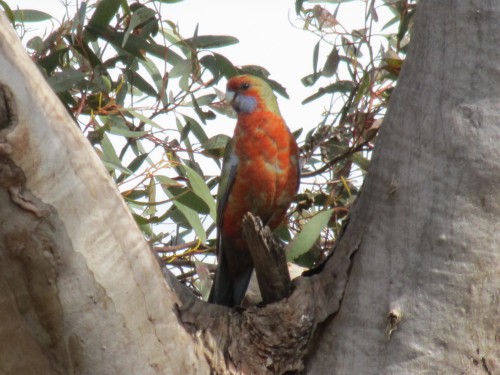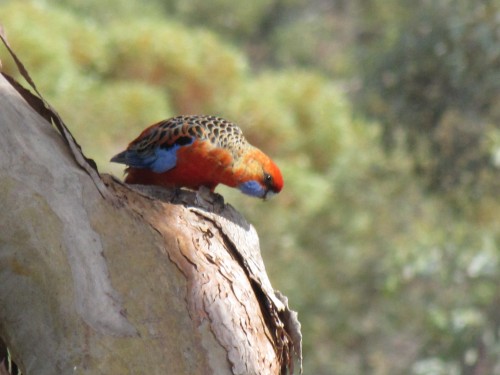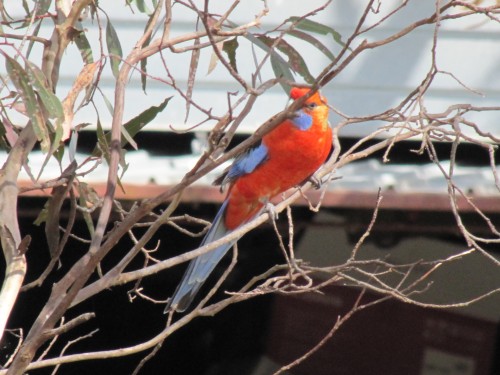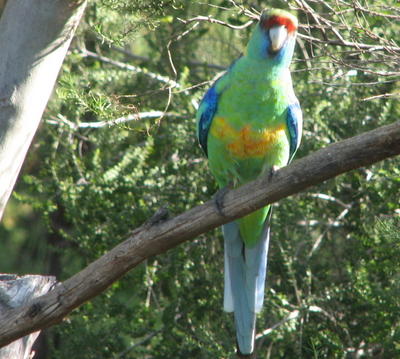Crimson Rosella in Murray Bridge
Crimson Rosellas are a common parrot of the eastern states of Australia. Here in South Australia they are largely confined to the south east of the state. A hybrid race called the Adelaide Rosella is common parrot of the Adelaide region, including the Mt Lofty Ranges and the mid-north of the state.
In recent years they have gradually expanded their range east towards our home here in Murray Bridge. I am seeing them here more and more often, including regular visitors to our garden.
To my surprise, we recently had two Crimson Rosellas briefly visit our garden. This is the first that we have observed in nearly 30 years living here. In today’s photos I show the two birds seen – one an adult quite significantly deeper in colour than the Adelaide Rosellas – the other in juvenile plumage.
This interesting observation raises several questions:
- Is this species expanding its range along with the Adelaide Rosella?
- Were these two birds aviary escapes, after all, they are relatively common cage birds in our area?
Further reading:
Sulphur Crested Cockatoos
Over the last few weeks on my regular travels to Adelaide to attend university lectures I have observed Sulphur Crested Cockatoos on many occasions. Sometimes they are perched on the over hanging branches of trees lining the freeway. Sometime they seem to be keeping a keen eye on the flow of traffic from the vantage point of the light pole.
Most of the time they are busy feeding on the roadside verges. Their numbers can vary from a half dozen or so through to several hundred. Set against the bright green grass they make quite a sight. From time to time they tolerate several interlopers: a Corella or two or several Galahs.
UPDATE: You can buy a large range of items featuring photos of this species – and many others – on TrevorsPhotos, including mugs, tee-shirts, aprons, coasters and many more items.
Bath time
While we were enjoying our lunch today two Australian Ringneck parrots came to our bird bath. They proceeded to have a very thorough soaking, as the photograph shows.
I guess that they were feeling rather hot. Today is the hottest day we have had since last summer. Spring here in Murray Bridge, South Australia, has been very mild, sometimes even cool with plenty of lovely rain.
Australian Ringneck
Working in the garden this afternoon I needed to stop what I was doing to take some photographs of a local species of parrot, the Australian Ringneck (also called Mallee Ringneck). I did not have to go looking for the bird in question. It was almost like it came looking for me! It flew right up to me in our plant nursery and sat on a nearby branch, not more than 3 metres away.
Of course, the camera was in the house, so I tried to casually walk into the house hoping that the ringneck would stay there. It didn’t but flew to a tree some 50 metres away. I continued working, all the time watching for the bird to return. I didn’t have to wait long. It settled in a tree near the house. I quietly went inside with the camera, planning to use our sun-room as a hide. We have three bird baths about six metres from a large picture window. We have had hundreds of very enjoyable meals watching the parade of birds coming to drink or bathe. Again, a very “good” waste of time, being very relaxing and enjoyable.
Today’s visitor was taking quite a deal of interest in the water. After taking some good photos through the window I decided to go outside and see how close I could get to the ringneck. I was able to get to about 3 metres away while the bird came down to the bird-bath and proceed to have a very thorough bath. I managed to get several more excellent photos. I then pressed the video button on the camera and filmed the bird washing and preening for about two minutes. I haven’t yet worked out whether I can make this video available on this blog.
Usually we have only two Australian Ringnecks around in the garden. In recent months there have been four, two of them juveniles. They aren’t in our garden constantly but rather roam over a wide range of the local environment. We usually love seeing them near to the house like today. When they decide to raid the orchard and nip the buds off the pear and apple trees we get just a tad annoyed – no – angry. We also get no fruit! Today I observed only one bird; I wonder if the other is nesting somewhere?
